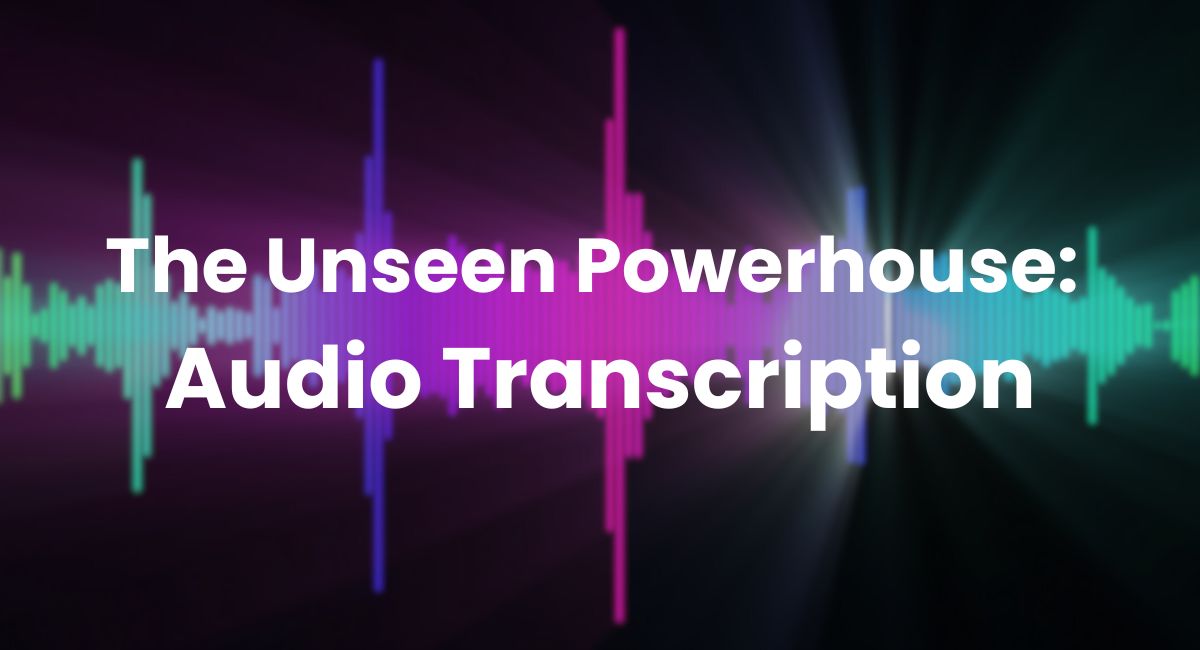What comes to mind when you hear the words “audio transcription?” You may picture a legal or medical office where an administrative assistant is taking dictation or working with a recording to create a document for their boss. But not many people realize that audio transcription is needed across various industries.
Audio transcriptions are necessary for sectors that include:
- Legal
- Healthcare
- Business
- Market research & consulting firms
- Academic
- Media & mass communications
- Podcast & YouTubers
- And many more
The types of transcriptions required do vary depending on the business. However, there’s a large amount of content that organizations need to transcribe. The need for transcription work is increasing, including in enterprises that reach global markets.
Table of Contents
What is Audio Transcription
Audio transcription takes dictated or recorded spoken words and converts them from audio into written text. The result is an audio transcript, which is a written document that comes from the conversion process.
There are different types of audio transcription formats, including the following:
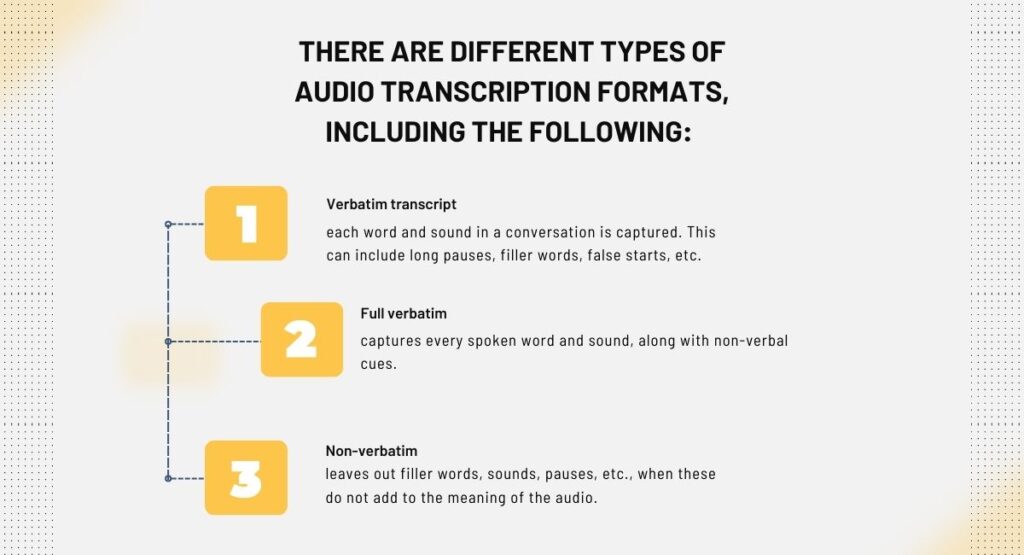
Verbatim transcript: each word and sound in a conversation is captured. This can include long pauses, filler words, false starts, etc. This type of transcription is often used where high accuracy is required, such as in academic or legal situations.
Full verbatim: captures every spoken word and sound, along with non-verbal cues. Full verbatim transcription is used in situations that require subtle emotions, psychological status, and more.
Non-verbatim: leaves out filler words, sounds, pauses, etc., when these do not add to the meaning of the audio. Non-verbatim transcription also corrects grammar and finishes incomplete sentences. This type of transcription is used when a formal yet easy-to-read transcript is required, such as in speeches or academic settings.
Detailed notes: offers a word-for-word transcription when accuracy is needed for essential passages but removes irrelevant or redundant information. It also summarizes the main points of the audio while maintaining the essential details. This type of transcription is often used when an accurate transcript is needed, such as in journalism or market research.
Audio transcription also involves different formatting elements, including the following:
- Speaker labels: Identify who is speaking in the audio.
- Timestamps: shows when a specific part of the audio is available on the recording.
- Inaudible and crosstalk tags: used for parts of the audio that overlap or are unintelligible.
- Sounds: descriptions used to identify background noises or non-speech sounds.
Related Post: Why Website Localization is Important for Going Global
A World Beyond Words: The Need for Audio Transcription
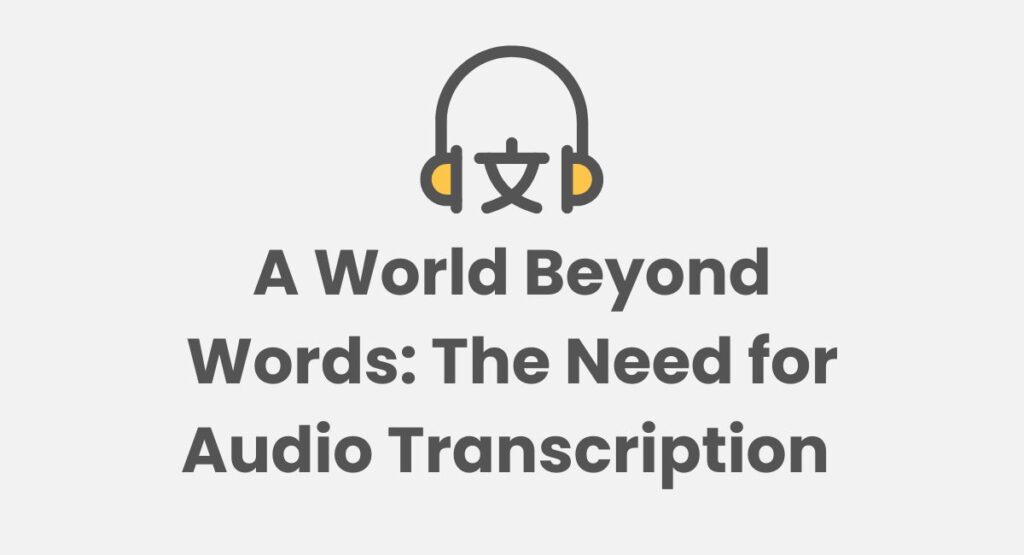
Audio transcription, a service in demand for decades, continues to hold its relevance in the 21st century. While automated transcription services do exist, they may not always match the accuracy or efficiency of human-made transcriptions.
There are many places where audio transcription is necessary, such as:
Accessibility
Audio transcription can make content more accessible for people with hearing issues or other difficulties understanding the spoken word. Reading content, rather than listening, can also help some people take in the content at their own pace.
In addition, audio transcriptions can also be translated into other languages, making content available to a broader audience. Accessibility can also be a legal requirement in some countries. You may find this requirement regarding web accessibility standards or regulations.
Searchability
Audio transcriptions also make it easier to find specific information within spoken content. When audio is transcribed, it’s possible to create a written document that can be searched, cross-referenced, and indexed.
For instance, this can be useful to reference specific information in a meeting. Other examples include interviews, podcasts, and more.
Analysis
Another benefit of audio transcription is that it allows for the deeper analysis of spoken words. It’s possible to review and analyze the language, tone, and other features in an audio recording.
Unravelling the Process of Audio Transcription
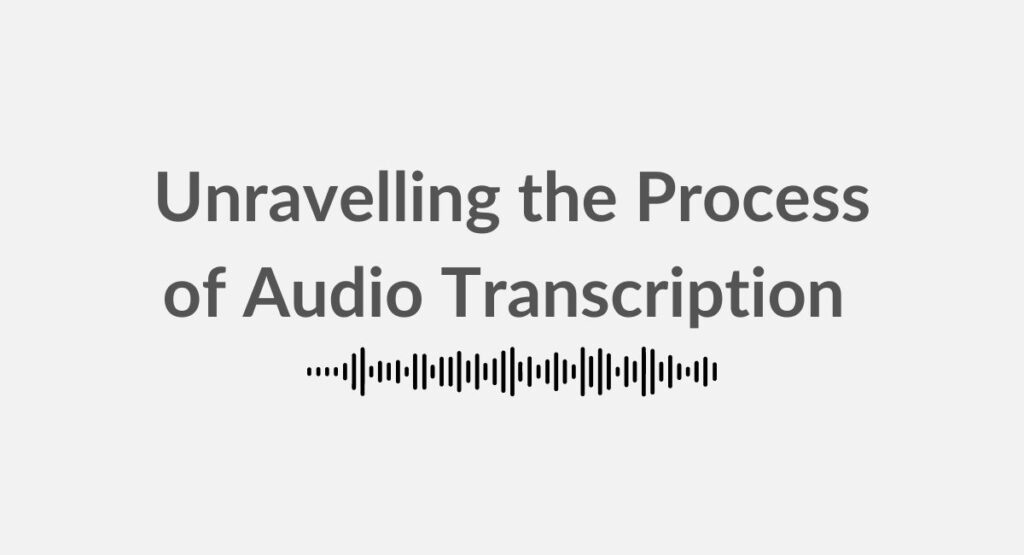
There are a few stages to the process of audio transcription, which we’ll briefly cover in this section.
1. Listening to the Entire Audio Recording
The first step is listening to the entire audio recording before transcription can begin. This is essential to the process. Listening to the audio first allows the transcriptionist to determine the style and substance of the spoken content. This can be especially helpful if there are speakers who have unfamiliar accents. In addition, it allows the transcriptionist to gain a comprehensive understanding of the content, including context, tone, and more.
Moreover, it’s also easier to distinguish different speakers, speech patterns, and tones. The overall effect of listening to the audio first improves the accuracy of the transcribing process.
2. Create the First Draft & Edit It
Next, the transcriptionist creates and edits the first draft of their work. The first draft is important, as it ensures that all the content in the audio has been captured accurately. This step also allows the transcriptionist to check the content for any omitted details. This is also the stage where speakers are identified, and the text is formatted into paragraphs, making the content easier to read.
Editing also takes place during the second step in audio transcription work. This is the time that grammatical and other errors are corrected. Formatting and punctuation are also checked for consistency and more.
3. Finalize the Transcript
The last step is finalizing the transcript document, which must be accurate and well-organized based on the original audio content. During this step, the entire document is reviewed in detail to find and correct errors, typos, and any other issues.
The transcriptionist proofreads the transcript and cross-checks it with the original audio to ensure accurate transcription of the content.
The audio transcription process can be challenging, but the goal is always to have an accurate record of the spoken content in the audio.
Accuracy in Transcription:
Accuracy in Transcription: Why It’s More Complicated Than It Sounds
While the steps above may make audio transcription appear to be easy, it’s actually more complicated than most people realize. Here are some of the most common challenges faced in audio transcription work.
Background Noise
The audio recording may have been done in a noisy area. Background noise may include construction noises, sounds of traffic, and more. The noise may make it difficult to hear some parts of the dialogue, and the sound may interrupt the recording in more than one place.
Unfamiliar Accents
Another common problem for transcriptionists is if one or more speakers has an unfamiliar accent. This can make the conversation difficult or impossible to understand.
Filler Words
Filler words are another common challenge in audio transcription work. The issue is that many people use words such as “Uh-huh” and “um,” amongst others. These words may make it more difficult to understand complete ideas when transcribing the conversation.
Grammatical Mistakes
One or more speakers may also make frequent grammatical mistakes during the recording. These errors usually don’t impact the transcription; however, they can make the work take longer.
Unintelligible Dialogue
There will be occasions when some parts of the dialogue are not audible or when a speaker may mumble, and other issues. These can be extremely challenging to handle in transcription work.
Technical Jargon
Another common problem for transcriptionists is technical jargon specific to a particular industry or business.
AI and Transcription: A Growing Relationship
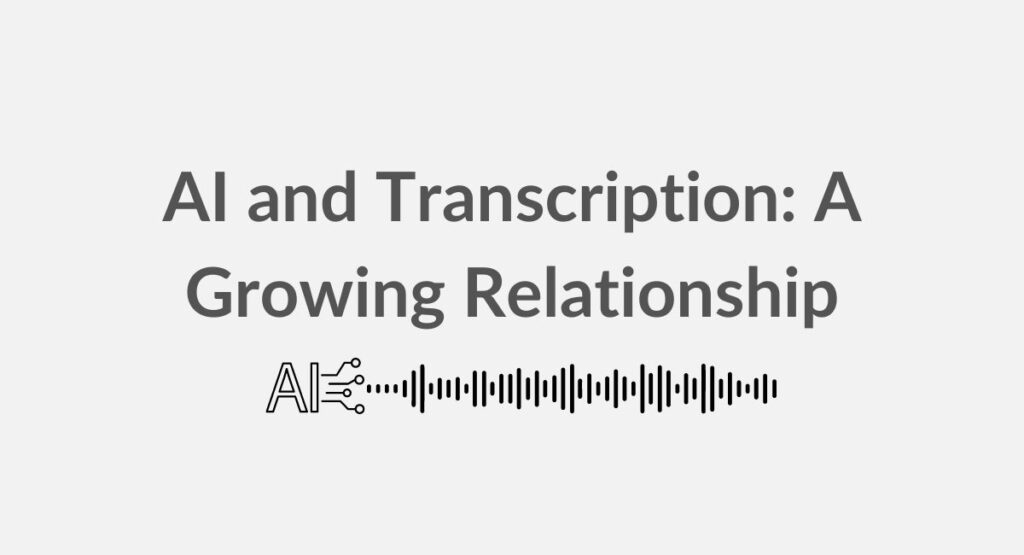
A more recent development in audio transcription is the use of AI for transcription. Here, the transcription work is done by AI (Artificial Intelligence), which converts human speech to text. The software “listens” to the audio and translates them into text.
The software uses Natural Language Processing (NLP), a type of AI that uses machine learning to understand human language. The process also involves deep learning, a subset of machine learning, which uses layers of processing to create neural networks.
One of the significant benefits of using AI for transcription is that the software automates repetitive work. AI is also more accurate in its transcription and gets the work done faster, usually within a matter of minutes.
The software also includes timestamps, identifies different speakers, and allows users to annotate the work. Finally, AI transcription software makes audio transcription more cost-effective for clients and the transcription agency. It can also boost a translation agency’s productivity, so they can get more projects completed.
On the other hand, AI transcription also has some limitations. For instance, the quality of the transcript may be lower than that done by a human transcriptionist. AI software may also have a hard time understanding accents or unfamiliar words.
In some cases, AI transcription software may not format the final document correctly. For example, before completion, the software may return only straight text that one must format. In addition, AI may not understand the context of some information.
AI transcription software can indeed be extremely helpful, but we should never solely rely on it. It’s always best practice to use AI transcription software combined with human intervention to ensure the quality and accuracy of the final transcript.
Human Transcription: The Irreplaceable Touch
Human transcription is usually best in all situations. We prefer human transcription over AI transcription for the following reasons, although both offer their benefits:
Higher accuracy: transcripts produced by humans is more accurate than AI transcription services.
Background noise: usually isn’t as big of an issue with human transcription. For instance, heavy traffic noise won’t distract or confuse a human transcriber, while these sounds could cause a problem for AI transcription software.
Deciphering accents: humans have an innate ability to understand a broad range of accents from around the world. With this ability, accents rarely cause issues with the quality of human transcriptions.
Verbatim transcriptions: in dialogues that require verbatim transcriptions, humans are the best choice. Word-for-word transcriptions leave nothing out of the text, including filler words, errors in grammar, etc. AI software may edit these out of the transcription, whereas a human includes the entire conversation to generate verbatim documents from audio transcriptions.
Pollion: Delivering Precision in Every Word
If you’re in need of a professional audio transcription service, Pollion offers professional audio transcription that uses a blend of technology and human expertise. Each project results in high-quality translations, with a fast turnaround.
This is an agency that caters to multiple languages, accents, and industries. Pollion uses a team of professional transcriptionists to ensure that their clients receive accurate, high-quality transcripts.
Future Trends in Audio Transcription
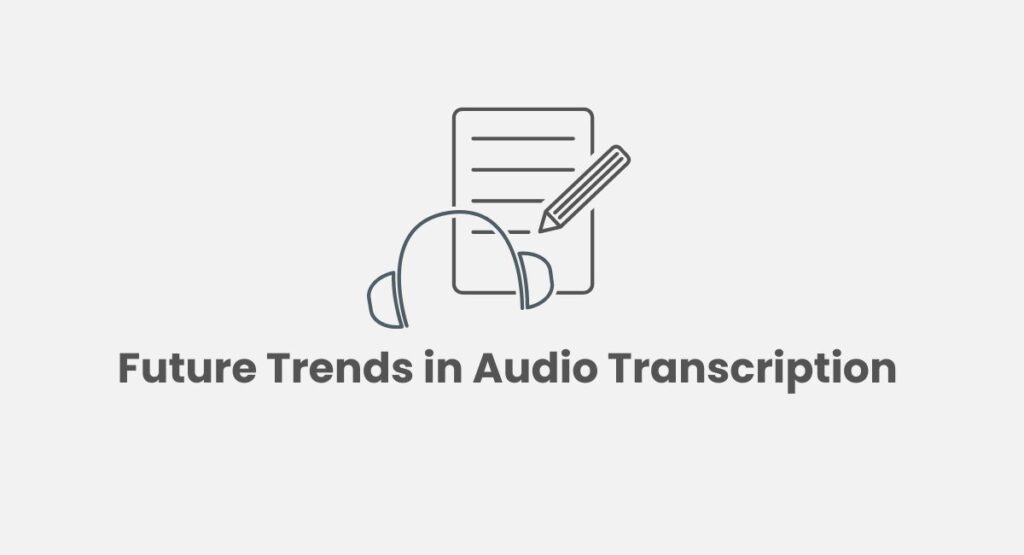
Through the years, audio transcription services have evolved to meet current requirements. Thankfully, the future remains bright for audio transcription as we move into the future.
The trends in audio transcription include a higher focus on security and privacy. With the use of AI in the transcription process, it’s necessary to ensure that all client data is kept secure. In addition, more companies will turn to transcription services for their audio content, such as podcasts, videos, presentations, and more. Transcriptions have been shown to increase audience engagement and retention.
AI will play a more important role as we move into the future of audio transcription. The software is continuously learning and improving, so audio transcription tools that rely on AI will become more popular and widely used.
Finally, an increase in quality and customer care will be seen in the audio transcription business. These are critical factors to ensure that audio transcription services are necessary and further developed in the future.
Conclusion: The Unseen Hero of Accessibility
Audio transcription services will remain essential for the foreseeable future. This is a service that not only enhances accessibility but gives clients the chance to analyze the spoken word like never before.
Professional transcription agencies, such as Pollion, provide high-quality, accurate audio translations for businesses worldwide.
